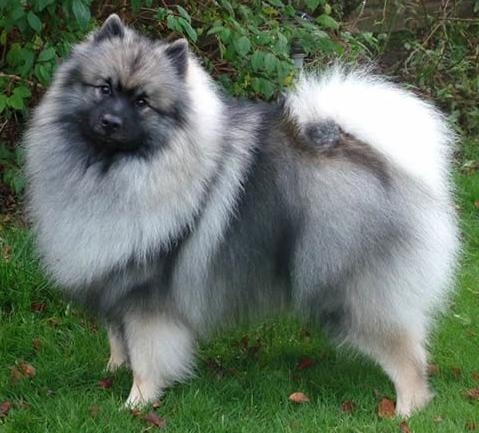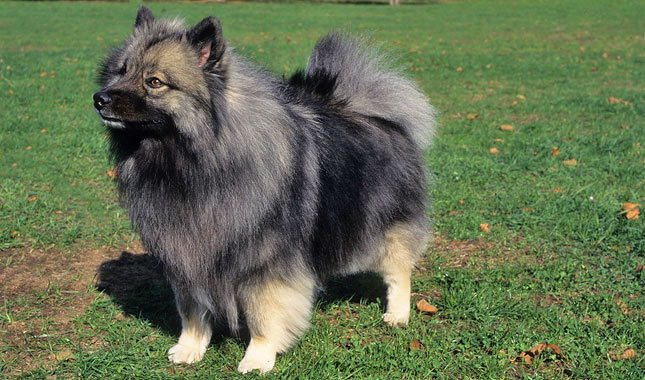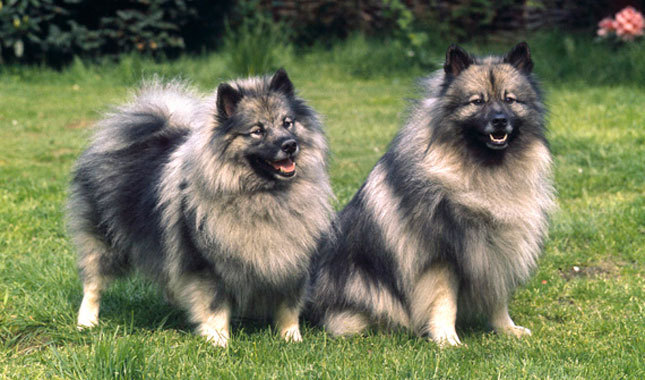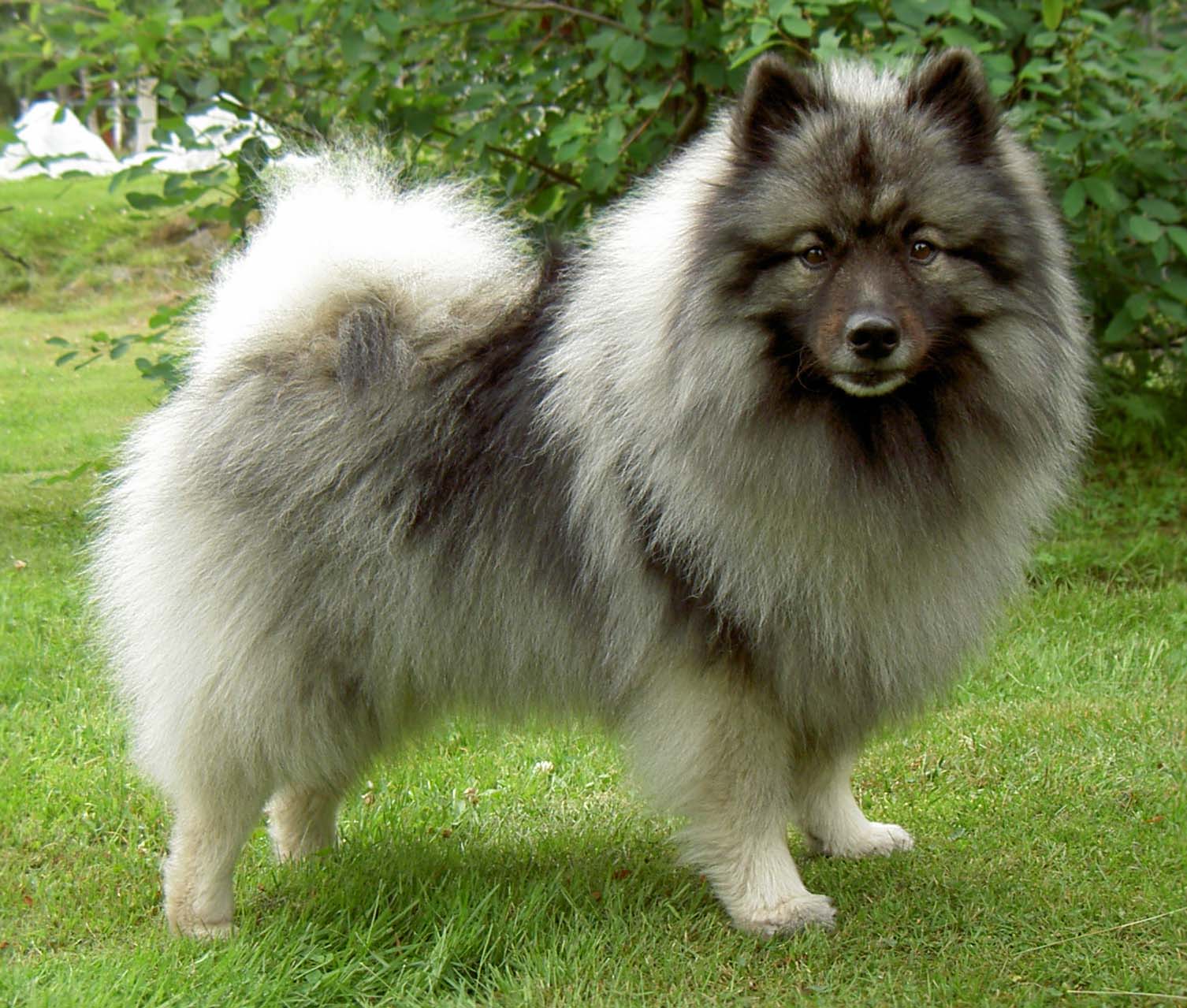
The Breed History
Originating in Holland about 300 years ago, Keeshonden (pl.) are
the National Dog of their country. The name derives from the
nickname of a politician, "Kees". This Spitz-type dog is related to
Northern breeds such as the Samoyed, Norwegian Elkhound and
Finnish Spitz. The breed ancestors likely originally came to Holland
from the North. Some also link this dog to the development of the
Pomeranian. The first breed standard was drawn up in 1933. First
AKC registration occurred in 1930. In Europe, they are considered
the same breed as the German Wolfspitz.
Breeding for Function
The Keeshond has always served a companionship role. They were
also used as a barge dog and a watchdog.
Physical Characteristics
Height at Withers: female 17" (43 cm), male 18" (45.5 cm)
Weight: 55-65 lb (25-29.5 kg)
Coat: The hair forms a lion's ruff and trousers particularly in the
male, and breed specific markings around the eyes are termed
spectacles. These markings include dark lines extending out from
the eyes. The undercoat is dense and colored gray or cream. The ears
are black or off-black, the tip of tail is black, and outer coat hairs
are straight and harsh. Black, gray and cream are melded together
in the coat, with the tips of the guard hairs colored black. The ruff
and trousers are lighter than the main coat color, as are the feet.
They go through a high shedding phase twice a year when they
blow their coats otherwise they have moderate grooming needs.
Longevity: 12-14 years
Points of Conformation: These dogs are compact and squarely
built, with moderately muscled and boned conformation and a
profuse standoff coat, a fox face with high head carriage and a
heavily plumed tail that rests closely over the back. The eyes are
medium-brown in color, almond shaped and the palpebral margins
are pigmented black. Ears are small and erect, high set, and the skull
is wedge shaped with a definite stop. Lips are black and tight, neck
is moderate in length, and the topline descends slightly towards the
rear. The thorax is rounded, the abdomen has moderate tuck up, and
limbs are straight boned. Feet are rounded and compact with black
nails. The gait is strong, showing lots of drive.
Recognized Behavior Issues and Traits
Reported breed attributes include: Stable temperament, a good
alert dog, playful, friendly with other dogs and especially good with
children, though independent minded. They don't tend to nuisance
bark. Their trainability is good. They don't tolerate hot humid
weather very well. The do well in city or country settings.
Normal Physiologic Variations
Tendency to become overweight.
Drug Sensitivities
None reported
Inherited Diseases
Elbow Dysplasia: Polygenically inherited trait causing elbow
arthritis. OFA reports 7.8% affected.
Hip Dysplasia: Polygenically inherited trait causing degenerative
joint disease and hip arthritis. OFA reports 6.3% affected.
Patella Luxation: Polygenically inherited laxity of patellar
ligaments, causing luxation, lameness, and later degenerative joint
disease. Treat surgically if causing clinical signs. Reported 4.4x odds
ratio versus other breeds. OFA reports 2.6% affected.
Primary Hyperparathyroidism: Autosomal dominant disorder with
age-dependant penetrance. Average age of onset is 11.2 years.
Affected dogs present with hypercalcemia, inappetence, polyuria,
polydipsia, and vomiting. Caused by a parathyroid gland adenoma.
Progresses to hypercalcemic kidney failure. Reported at a frequency
of 1.87% in the KCA Health Survey 2000. A linked-marker genetic
test is available, reporting 4.1% affected.
Cono-Truncal Septal Defect: A group of genetically and
embryologically related cardiac malformations, including
sub-clinical defects of the conal septum, conal ventricular septal
defects, tetralogy of Fallot, and persistent truncus arteriosus. Three
predisposing gene markers are identified, showing a polygenic
mode of inheritance.
Disease Predispositions
Hypothyroidism: Inherited autoimmune thyroiditis. 6.4% positive
for thyroid auto-antibodies based on testing at Michigan State
University. (Ave. for all breeds is 7.5%).
Distichiasis: Abnormally placed eyelashes that irritate the cornea
and conjunctiva. Can cause secondary corneal ulceration. Identified
in 5.66% of Keeshonden CERF examined by veterinary ophthalmologists
between 2000-2005.
Cataracts: Posterior suture punctate cataracts predominate in the
breed. Age of onset 1-3 years. Identified in 5.27% of Keeshonden
CERF examined by veterinary ophthalmologists between 2000-2005.
CERF does not recommend breeding any Keeshond with a cataract.
Allergic Dermatitis (Atopy): Inhalant or food allergy. Presents
with pruritis and pyotraumatic dermatitis (hot spots). Reported at a
frequency of 3.19% in the KCA Health Survey 2000.
Inherited Epilepsy: Generalized or partial seizures. Control with
anticonvulsant medication. Age of onset 6 months to 3 years. Dorn
reports a 9.36x odds ratio versus other breeds. One study suggests
an autosomal recessive mode of inheritance. Seizures are reported
at a frequency of 2.88% in the KCA Health Survey 2000.
Alopecia-X (Coat Funk): Progressive, symmetrical, non-pruritic,
truncal hair loss usually beginning in early adulthood. ACTH
stimulation test, low-dose dexamethazone stimulation test, and
thyroid panel results are normal. Elevated blood concentrations of
17-hydroxyprogesterone (17-OHP) are seen post ACTH stimulation.
Partial hair regrowth is reported in Keeshonden treated with
melatonin. Reported at a frequency of 2.41% in the KCA Health
Survey 2000. Unknown mode of inheritance.
Juvenile Diabetes Mellitus: Caused by a lack of insulin production
by the pancreas. Controlled by insulin injections, diet, and glucose
monitoring. Affected dogs also form glucose-related cataracts.
Age of onset 2-6 months. Breeding studies suggest an autosomal
recessive mode of inheritance. Reported at a frequency of 0.78% in
the KCA Health Survey 2000.
Bladder Stones: One study reports a 5.47x odds ratio of forming
calcium oxalate stones versus other breeds. Dorn reports a 2.81x
odds ratio versus other breeds. Composition of calculi not reported.
Reported at a frequency of 0.31% in the KCA Health Survey
2000.
Spontaneous Chronic Corneal Epithelial Defects (SCCED):
Keeshonden are reported as a breed with an increased prevalence of
spontaneous corneal epithelial defects. Research indicates a role of
substance P.
Central progressive Retinal Atrophy, Cutaneous Asthenia, Optic
Nerve Hypoplasia, Oligodontia, and von Willebrand's Disease are
reported.
Isolated Case Studies
Renal Cortical Hypoplasia: Congenital kidney disease was reported
in a litter of Keeshonds.
Malignant Fibrous Histiocytoma: Identified in a retrobulbar
location in a 12-year-old castrated male Keeshond dog.
Genetic Tests
Tests of Genotype: Linked marker test is available for Primary
Hyperparathyroidism from the Goldstein lab at Cornell (www.vet.
cornell.edu/labs/goldstein/).
Tests of Phenotype: CHIC Certification: Hip and elbow
radiographs, CERF eye examination, and patella evaluation.Recommend thyroid profile including autoantibodies and cardiac
examination.
Miscellaneous
- Breed name synonyms: Keeshound, Wolfspitz (German), Chien
Loup (Fr.), Lupini (Italy), Dutch Barge Dog (historical-England),
Dutch Keeshond.
- Registries: AKC, UKC, CKC, KCGB (Kennel Club of Great Britain),
ANKC (Australian National Kennel Club), NKC (National Kennel Club)
- AKC rank (year 2008): 95 (630 dogs registered)
- Internet resources: The Keeshond Club of America:
www.keeshond.org
The Keeshond Club UK: www.keeshondclub.org.uk
The Keeshond Club of Canada: www.keeshondcanada.com
Photo Gallery of Breed - Keeshond - Dog Breed








 Animalia Life
Animalia Life